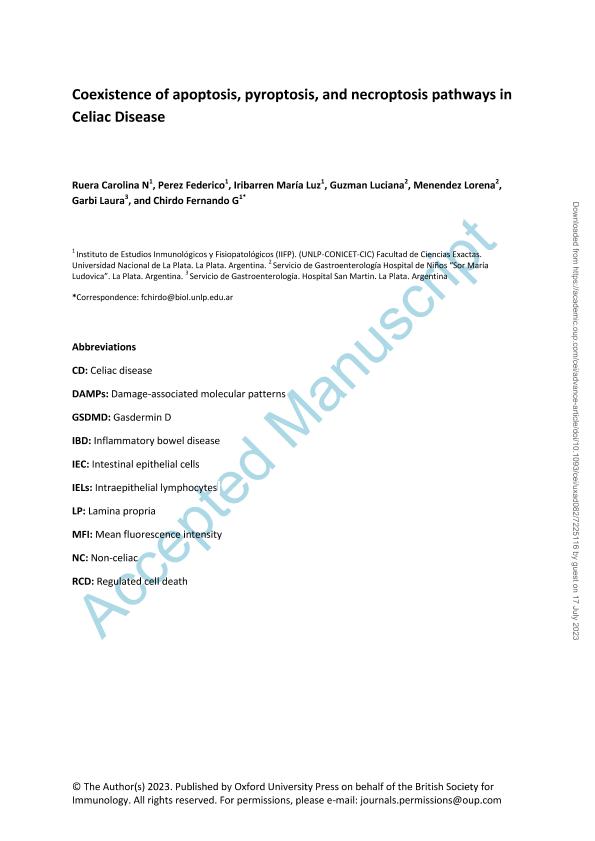Artículo
Coexistence of apoptosis, pyroptosis, and necroptosis pathways in Celiac Disease
Ruera, Carolina Naymé ; Perez, Federico; Iribarren, María Luz; Guzman, Luciana; Menendez, Lorena; Garbi, Laura; Chirdo, Fernando Gabriel
; Perez, Federico; Iribarren, María Luz; Guzman, Luciana; Menendez, Lorena; Garbi, Laura; Chirdo, Fernando Gabriel
 ; Perez, Federico; Iribarren, María Luz; Guzman, Luciana; Menendez, Lorena; Garbi, Laura; Chirdo, Fernando Gabriel
; Perez, Federico; Iribarren, María Luz; Guzman, Luciana; Menendez, Lorena; Garbi, Laura; Chirdo, Fernando Gabriel
Fecha de publicación:
12/2023
Editorial:
Wiley Blackwell Publishing, Inc
Revista:
Clinical and Experimental Immunology
ISSN:
0009-9104
Idioma:
Inglés
Tipo de recurso:
Artículo publicado
Clasificación temática:
Resumen
Usually, the massive elimination of cells under steady-state conditions occurs by apoptosis, which is also acknowledged to explain the loss of enterocytes in the small intestine of celiac disease (CD) patients. However, little is known about the role of proinflammatory cell death pathways in CD. Here, we have used confocal microscopy, western blot, and RT-qPCR analysis to assess the presence of regulated cell death pathways in the duodenum of CD patients. We found an increased number of dead (TUNEL+) cells in the lamina propria of small intestine of CD patients, most of them are plasma cells (CD138+). Many dying cells expressed FAS and were in close contact with CD3+ T cells. Caspase-8 and caspase-3 expression was increased in CD, confirming the activation of apoptosis. In parallel, caspase-1, IL-1β, and GSDMD were increased in CD samples indicating the presence of inflammasome-dependent pyroptosis. Necroptosis was also present, as shown by the increase of RIPK3 and phosphorylate MLKL. Analysis of published databases confirmed that CD has an increased expression of regulated cell death -related genes. Together, these results reveal that CD is characterized by cell death of different kinds. In particular, the presence of proinflammatory cell death pathways may contribute to mucosal damage.
Archivos asociados
Licencia
Identificadores
Colecciones
Articulos(IIFP)
Articulos de INST. DE ESTUDIOS INMUNOLOGICOS Y FISIOPATOLOGICOS
Articulos de INST. DE ESTUDIOS INMUNOLOGICOS Y FISIOPATOLOGICOS
Citación
Ruera, Carolina Naymé; Perez, Federico; Iribarren, María Luz; Guzman, Luciana; Menendez, Lorena; et al.; Coexistence of apoptosis, pyroptosis, and necroptosis pathways in Celiac Disease; Wiley Blackwell Publishing, Inc; Clinical and Experimental Immunology; 214; 3; 12-2023; 328-340
Compartir
Altmétricas



